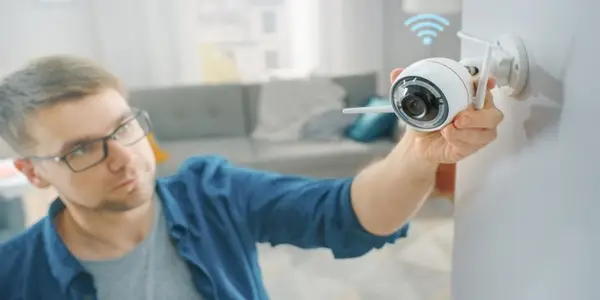Home Security Cameras—How Many Do You Need and Where to Place Them

Home security is like health: it’s best to be proactive. Considering how convenient and user-friendly home security systems are today, why wait until you have a bad experience like theft or vandalism to protect your home?
Determining the right system for your needs, though, can be somewhat confusing. Let’s start with the most obvious question: How many security cameras do you need and where should they be placed? In this article, we’ll answer these questions and go over other key points about how to set up your home security system.
A Minimum of 5 Exterior Cameras
The most important thing to know about your home security is that it should be a cohesive system, a collection of pieces that work together. Home security systems are a natural addition to your smart home. For the exterior of your home, you’ll want to place cameras in the following locations:
- Front and back doors
- Both sides of the house
- Entry to the garage.
This basic setup is a great place to start, but consider other places you can locate cameras, too. Take a walk around your property and look for areas that are vulnerable, or where someone with ill intent might see a weakness. Maybe it’s a dark side yard that offers cover to a thief trying to get through the garage window. Also, consider installing a camera that captures the street in front of your house. If you notice a car repeatedly driving down your street slowly after dark, take note, alert the police, and mention it to your neighbors. More visibility equals more security.
Minimum of 2 Interior Cameras
For the interior of your home, at a minimum, you’ll want cameras in:
- The living room
- Any room with valuables or a safe.
Other places to consider adding a camera are in the basement with a view of any windows that an intruder could break to gain entry, the main front and rear entry zones, and the upper hallway, if your home has an upper level. It stands to reason that the more area you can cover with cameras, the better chance you have to capture any suspicious activity. This also will provide more peace of mind when it comes to covering areas that are more vulnerable.
High and Obvious Installation
Every camera should be mounted as high on the wall or ceiling as possible so an intruder would find it difficult to get to. It’s also best to mount cameras in plain sight in the hope that doing so will deter intruders. The strategy here is to make intruding seem risky and get the bad guys to move on. Short of bars on the windows and armed security guards, you cannot prevent all intrusions, but you can make your home appear to be more protected—because it is.
Where Not to Install
Security cameras do not belong everywhere, however. There are some places security cameras simply don’t belong. For example, don’t place cameras in:
- Locations that capture neighboring properties. Since it’s completely possible to design your security system to avoid this, and it’s reasonable for your neighbors to object to your cameras if pointed at their space, don’t do it.
- Bedrooms, except possibly for children’s bedrooms. This distinction should be clear, but in plain language, a bedroom is reasonably assumed to be a private space for your adult guests. But the responsibility of adults to ensure the well-being of children anywhere in the home trumps any privacy concerns of children.
- Bathrooms. You can’t in good conscience place a security camera in any bathroom that a guest might use. That’s a gross violation of privacy and more than a bit creepy. You can, however, place a camera in the hallway outside the bathroom. No problem.
Although each situation can vary slightly, we recommend a minimum of 7 security cameras be placed around and in your home: 5 exterior and 2 interior cameras. As you design your new security system, remember that you can always contact the trusted professionals at your local Mr. Handyman for help. They have the know-how, experience, and expertise to recommend and install a home security system that covers all the bases and gives you comfort knowing you and your family are well protected.
 Click to call
Click to call


